A Machine Learning-Based Interest Flooding Attack Detection System in Vehicular Named Data Networking
Abstract
:1. Introduction
- We propose an ML-based classification technique to identify attackers and legitimate vehicles.
- We evaluate the accuracy of five ML classifiers and propose the most accurate algorithm for IFA detection.
- Based on our ML-based detection results, we propose a simulation-based IFA prevention system in intermediate nodes.
2. Related Work
3. System Model
3.1. Proposed Network Architecture
Vehicle to RSU Communication
3.2. ML Classification-Based Attack Detection
3.2.1. Dataset Collection
3.2.2. Data Preprocessing
3.2.3. Classification
- DT: The DT [52] is a significant method for reaching conclusions based on a set of rules derived from a tree-like structure. We selected DT due to its outstanding capabilities in capturing nonlinear relationships and handling categorical features often utilized in VNDN datasets. Its interpretability offers insights into the decision-making process, aiding in understanding detected attack patterns. The tree comprises two nodes: a decision node and a leaf node. Decision nodes determine the attribute that needs to be selected for further analysis, while leaf nodes represent the final class outcome. The DT employs a top-down approach to provide results. The root is placed at the top of the tree, which acts as the initial decision node. DT uses the information gain technique to select each subsequent DT node, ensuring that each part of the tree selects the most informative attributes. This enables DT to classify and predict results based on the input data characteristics and patterns.
- KNN: The KNN algorithm [53] is the most used ML classifier, popular for its effectiveness in dealing with large datasets. KNN is deemed a suitable ML classifier for recognizing local clustering, which is an essential trait for detecting attack occurrences that might exhibit spatial proximity. It is a simple and flexible classifier that can be applied to regression and classification purposes. The KNN involves categorizing the latest data points by assigning them to the most common class among their K-nearest neighbors in the training set. The KNN then provides the majority class label or the average value of those neighbors. Considering the appropriate value of K is essential and depends on the specific characteristics of the dataset, making KNN a versatile and adaptive choice for various ML scenarios.
- RF: RF [54] combines multiple base models to make predictions. Given the potential noise and outliers in VNDN data, RF’s ability to handle such variations becomes crucial. This approach is often called “bootstrapping and aggregation”, where the majority vote of the base models on the test data determines the final result. In the RF approach, the data are fed to the base models using row sampling with replacement, a method known as bagging.
- GNB: GNB [55] is a simple yet effective classification method that employs Bayes’ theorem for predicting the class of unlabeled data points. We selected GNB for its efficiency in high-dimensional data handling and probabilistic nature, allowing it to capture the likelihood of feature co-occurrences relevant to IFA scenarios. It calculates the prior probabilities of different classes and utilizes this information to make predictions on new, unseen data. One of the key assumptions of GNB is the independence of features, which means that it assumes each feature contributes to the classification independently of other features. This independence assumption simplifies the computation and makes GNB computationally efficient. Due to its simplicity and efficiency, GNB is particularly well-suited for applications with many features and is commonly used in various ML tasks.
- LR: The LR [56] is a statistical method used for predicting the probability of categorical variables, especially in two-class classification problems. It is a well-established binary classification technique for IFA detection. It utilizes a logistic function to calculate an event’s likelihood.
3.2.4. Model Evaluation
- True positive (TP): represents the count of positive samples correctly classified.
- False positive (FP): indicates the count of samples incorrectly classified as positive.
- True negative (TN): refers to the count of negative samples correctly classified.
- False negative (FN): signifies the count of samples incorrectly classified as negative.
3.3. Attack Prevention System
| Algorithm 1 Interest packet verification mechanism. |
|
4. Experimental Results and Discussion
4.1. ML Evaluation Results
Visualized Results
4.2. IFA Prevention Results
4.3. Discussion
5. Conclusions
6. Future Work
Author Contributions
Funding
Data Availability Statement
Acknowledgments
Conflicts of Interest
References
- Min, H.; Fang, Y.; Wu, X.; Lei, X.; Chen, S.; Teixeira, R.; Zhu, B.; Zhao, X.; Xu, Z. A fault diagnosis framework for autonomous vehicles with sensor self-diagnosis. Expert Syst. Appl. 2023, 224, 120002. [Google Scholar] [CrossRef]
- World Health Organization Statistics. 2023. Available online: https://www.who.int/data/gho/publications/world-health-statistics (accessed on 14 July 2023).
- Shelke, S.; Pundge, A. A Comparative Analysis and Study of Vehicular Ad Hoc Network. In Proceedings of the International Conference on Applications of Machine Intelligence and Data Analytics (ICAMIDA 2022), Aurangabad, India, 22 December 2022; Atlantis Press: Amsterdam, The Netherlands, 2023; pp. 366–381. [Google Scholar]
- Chen, S.; Hu, J.; Zhao, L.; Zhao, R.; Fang, J.; Shi, Y.; Xu, H. Cellular Vehicle-to-Everything (C-V2X); Springer: Berlin/Heidelberg, Germany, 2023. [Google Scholar]
- Liang, L.; Peng, H.; Li, G.Y.; Shen, X. Vehicular communications: A physical layer perspective. IEEE Trans. Veh. Technol. 2017, 66, 10647–10659. [Google Scholar] [CrossRef]
- Naeem, M.A.; Rehman, M.A.U.; Ullah, R.; Kim, B.S. A comparative performance analysis of popularity-based caching strategies in named data networking. IEEE Access 2020, 8, 50057–50077. [Google Scholar] [CrossRef]
- Khelifi, H.; Luo, S.; Nour, B.; Moungla, H.; Faheem, Y.; Hussain, R.; Ksentini, A. Named data networking in vehicular ad hoc networks: State-of-the-art and challenges. IEEE Commun. Surv. Tutor. 2019, 22, 320–351. [Google Scholar] [CrossRef]
- Xylomenos, G.; Ververidis, C.N.; Siris, V.A.; Fotiou, N.; Tsilopoulos, C.; Vasilakos, X.; Katsaros, K.V.; Polyzos, G.C. A survey of information-centric networking research. IEEE Commun. Surv. Tutor. 2013, 16, 1024–1049. [Google Scholar] [CrossRef]
- Jacobson, V.; Smetters, D.K.; Thornton, J.D.; Plass, M.F.; Briggs, N.H.; Braynard, R.L. Networking named content. In Proceedings of the 5th International Conference on Emerging Networking Experiments and Technologies, Rome, Italy, 1–4 December 2009; pp. 1–12. [Google Scholar]
- Ambrosin, M.; Compagno, A.; Conti, M.; Ghali, C.; Tsudik, G. Security and privacy analysis of national science foundation future internet architectures. IEEE Commun. Surv. Tutor. 2018, 20, 1418–1442. [Google Scholar] [CrossRef]
- Ahmed, S.H.; Bouk, S.H.; Yaqub, M.A.; Kim, D.; Song, H.; Lloret, J. CODIE: Controlled Data and Interest Evaluation in Vehicular Named Data Networks. IEEE Trans. Veh. Technol. 2016, 65, 3954–3963. [Google Scholar] [CrossRef]
- Song, T.; Yuan, H.; Crowley, P.; Zhang, B. Scalable name-based packet forwarding: From millions to billions. In Proceedings of the 2nd ACM Conference on Information-Centric Networking, San Francisco, CA, USA, 30 September–2 October 2015; pp. 19–28. [Google Scholar]
- Benmoussa, A.; Kerrache, C.A.; Lagraa, N.; Mastorakis, S.; Lakas, A.; Tahari, A.E.K. Interest Flooding Attacks in Named Data Networking: Survey of Existing Solutions, Open Issues, Requirements, and Future Directions. Acm Comput. Surv. 2022, 55, 1–37. [Google Scholar] [CrossRef]
- Magsi, A.H.; Yovita, L.V.; Ghulam, A.; Muhammad, G.; Ali, Z. A Content Poisoning Attack Detection and Prevention System in Vehicular Named Data Networking. Sustainability 2023, 15, 10931. [Google Scholar] [CrossRef]
- Al-Shareeda, M.A.; Manickam, S. Man-in-the-middle attacks in mobile ad hoc networks (MANETs): Analysis and evaluation. Symmetry 2022, 14, 1543. [Google Scholar] [CrossRef]
- Lo, N.W.; Tsai, H.C. Illusion attack on vanet applications-a message plausibility problem. In Proceedings of the 2007 IEEE Globecom Workshops, Washington, DC, USA, 26–30 November 2007; pp. 1–8. [Google Scholar]
- Kumar, N.; Singh, A.K.; Aleem, A.; Srivastava, S. Security attacks in named data networking: A review and research directions. J. Comput. Sci. Technol. 2019, 34, 1319–1350. [Google Scholar] [CrossRef]
- Pu, C.; Payne, N.; Brown, J. Self-adjusting share-based countermeasure to interest flooding attack in named data networking. In Proceedings of the 2019 International Conference on Internet of Things (iThings) and IEEE Green Computing and Communications (GreenCom) and IEEE Cyber, Physical and Social Computing (CPSCom) and IEEE Smart Data (SmartData), Atlanta, GA, USA, 14–17 July 2019; pp. 142–147. [Google Scholar]
- Wu, Z.; Feng, W.; Yue, M.; Xu, X.; Liu, L. Mitigation measures of collusive interest flooding attacks in named data networking. Comput. Secur. 2020, 97, 101971. [Google Scholar] [CrossRef]
- Khelifi, H.; Luo, S.; Nour, B.; Moungla, H.; Ahmed, S.H.; Guizani, M. A blockchain-based architecture for secure vehicular Named Data Networks. Comput. Electr. Eng. 2020, 86, 106715. [Google Scholar] [CrossRef]
- Gasti, P.; Tsudik, G.; Uzun, E.; Zhang, L. DoS and DDoS in named data networking. In Proceedings of the 2013 22nd International Conference on Computer Communication and Networks (ICCCN), Nassau, Bahamas, 30 July–2 August 2013; pp. 1–7. [Google Scholar]
- Zhang, X.; Li, R. A charging/rewarding mechanism-based interest flooding attack mitigation strategy in NDN. In Proceedings of the 2019 IFIP/IEEE Symposium on Integrated Network and Service Management (IM), Arlington, VA, USA, 8–12 April 2019; pp. 402–407. [Google Scholar]
- Apruzzese, G.; Laskov, P.; Montes de Oca, E.; Mallouli, W.; Brdalo Rapa, L.; Grammatopoulos, A.V.; Di Franco, F. The role of machine learning in cybersecurity. Digit. Threat. Res. Pract. 2023, 4, 1–38. [Google Scholar] [CrossRef]
- Alghanmi, N.; Alotaibi, R.; Buhari, S.M. Machine learning approaches for anomaly detection in IoT: An overview and future research directions. Wirel. Pers. Commun. 2022, 122, 2309–2324. [Google Scholar] [CrossRef]
- Alanazi, A. Using machine learning for healthcare challenges and opportunities. Inform. Med. Unlocked 2022, 30, 100924. [Google Scholar] [CrossRef]
- Guan, Z.; Jing, J.; Deng, X.; Xu, M.; Jiang, L.; Zhang, Z.; Li, Y. DeepMIH: Deep invertible network for multiple image hiding. IEEE Trans. Pattern Anal. Mach. Intell. 2022, 45, 372–390. [Google Scholar] [CrossRef] [PubMed]
- Wu, Z.; Cao, J.; Wang, Y.; Wang, Y.; Zhang, L.; Wu, J. hPSD: A hybrid PU-learning-based spammer detection model for product reviews. IEEE Trans. Cybern. 2018, 50, 1595–1606. [Google Scholar] [CrossRef]
- Rasheed, I.; Asif, M.; Ihsan, A.; Khan, W.U.; Ahmed, M.; Rabie, K.M. LSTM-based distributed conditional generative adversarial network for data-driven 5G-enabled maritime UAV communications. IEEE Trans. Intell. Transp. Syst. 2022, 24, 2431–2446. [Google Scholar] [CrossRef]
- Hassan, F.; Yu, J.; Syed, Z.S.; Ahmed, N.; Al Reshan, M.S.; Shaikh, A. Achieving model explainability for intrusion detection in VANETs with LIME. PeerJ Comput. Sci. 2023, 9, e1440. [Google Scholar] [CrossRef]
- Yao, Y.; Zhao, J.; Li, Z.; Cheng, X.; Wu, L. Jamming and Eavesdropping Defense Scheme Based on Deep Reinforcement Learning in Autonomous Vehicle Networks. IEEE Trans. Inf. Forensics Secur. 2023, 18, 1211–1224. [Google Scholar] [CrossRef]
- Liang, H.; Burgess, L.; Liao, W.; Wang, Q.; Yu, W. 16 On Detecting Interest Flooding Attacks in Named Data Networking (NDN)–based IoT Searches. In AI, Machine Learning and Deep Learning: A Security Perspective; CRC: Boca Raton, FL, USA, 2023. [Google Scholar]
- Hasan, T.; Malik, J.; Bibi, I.; Khan, W.U.; Al-Wesabi, F.N.; Dev, K.; Huang, G. Securing industrial internet of things against botnet attacks using hybrid deep learning approach. IEEE Trans. Netw. Sci. Eng. 2022. [Google Scholar] [CrossRef]
- Khan, W.U.; Nguyen, T.N.; Jameel, F.; Jamshed, M.A.; Pervaiz, H.; Javed, M.A.; Jäntti, R. Learning-based resource allocation for backscatter-aided vehicular networks. IEEE Trans. Intell. Transp. Syst. 2021, 23, 19676–19690. [Google Scholar] [CrossRef]
- Li, B.; Zhou, X.; Ning, Z.; Guan, X.; Yiu, K.F.C. Dynamic event-triggered security control for networked control systems with cyber-attacks: A model predictive control approach. Inf. Sci. 2022, 612, 384–398. [Google Scholar] [CrossRef]
- Safwat, M.; Elgammal, A.; AbdAllah, E.G.; Azer, M.A. Survey and taxonomy of information-centric vehicular networking security attacks. Ad Hoc Netw. 2022, 124, 102696. [Google Scholar] [CrossRef]
- Zhang, J.; Peng, S.; Gao, Y.; Zhang, Z.; Hong, Q. APMSA: Adversarial perturbation against model stealing attacks. IEEE Trans. Inf. Forensics Secur. 2023, 18, 1667–1679. [Google Scholar] [CrossRef]
- Han, S.; Ding, H.; Zhao, S.; Ren, S.; Wang, Z.; Lin, J.; Zhou, S. Practical and Robust Federated Learning With Highly Scalable Regression Training. IEEE Trans. Neural Netw. Learn. Syst. 2023. [Google Scholar] [CrossRef]
- Compagno, A.; Conti, M.; Gasti, P.; Tsudik, G. NDN interest flooding attacks and countermeasures. In Proceedings of the Annual Computer Security Applications Conference, Orlando, FL, USA, 3–7 December 2012. [Google Scholar]
- Salah, H.; Wulfheide, J.; Strufe, T. Coordination supports security: A new defence mechanism against interest flooding in NDN. In Proceedings of the 2015 IEEE 40th Conference on Local Computer Networks (LCN), Clearwater Beach, FL, USA, 26–29 October 2015; pp. 73–81. [Google Scholar]
- Salah, H.; Strufe, T. Evaluating and mitigating a collusive version of the interest flooding attack in NDN. In Proceedings of the 2016 IEEE Symposium on Computers and Communication (ISCC), Messina, Italy, 27–30 June 2016; pp. 938–945. [Google Scholar]
- Wang, K.; Zhou, H.; Qin, Y.; Chen, J.; Zhang, H. Decoupling malicious interests from pending interest table to mitigate interest flooding attacks. In Proceedings of the 2013 IEEE Globecom Workshops (GC Wkshps), Atlanta, GA, USA, 9–13 December 2013; pp. 963–968. [Google Scholar]
- Nguyen, T.; Mai, H.L.; Cogranne, R.; Doyen, G.; Mallouli, W.; Nguyen, L.; El Aoun, M.; De Oca, E.M.; Festor, O. Reliable detection of interest flooding attack in real deployment of named data networking. IEEE Trans. Inf. Forensics Secur. 2019, 14, 2470–2485. [Google Scholar] [CrossRef]
- Nguyen, T.; Cogranne, R.; Doyen, G. An optimal statistical test for robust detection against interest flooding attacks in ccn. In Proceedings of the 2015 IFIP/IEEE International Symposium on Integrated Network Management (IM), Ottawa, ON, Canada, 11–15 May 2015; pp. 252–260. [Google Scholar]
- Ding, K.; Liu, Y.; Cho, H.H.; Chao, H.C.; Shih, T.K. Cooperative detection and protection for interest flooding attacks in named data networking. Int. J. Commun. Syst. 2016, 29, 1968–1980. [Google Scholar] [CrossRef]
- Xin, Y.; Li, Y.; Wang, W.; Li, W.; Chen, X. A novel interest flooding attacks detection and countermeasure scheme in NDN. In Proceedings of the 2016 IEEE Global Communications Conference (GLOBECOM), Washington, DC, USA, 4–8 December 2016; pp. 1–7. [Google Scholar]
- Azmi, M.A.H.; Foozy, C.F.M.; Sukri, K.A.M.; Abdullah, N.A.; Hamid, I.R.A.; Amnur, H. Feature Selection Approach to Detect DDoS Attack Using Machine Learning Algorithms. JOIV Int. J. Inform. Vis. 2021, 5, 395–401. [Google Scholar] [CrossRef]
- Subasri, I.; GSR, E.S.; Ramkumar, M. Machine Learning Based Feature Selection for DDoS Detection in Named Data Networking. In Proceedings of the 2022 4th International Conference on Advances in Computing, Communication Control and Networking (ICAC3N), Greater Noida, India, 16–17 December 2022; pp. 305–310. [Google Scholar]
- Yaqub, M.A.; Ahmed, S.H.; Kim, D. A detailed simulation study of the push-based protocol for critical data dissemination in vehicular named data networks. In Proceedings of the 2019 International Conference on Networking and Network Applications (NaNA), Daegu, Republic of Korea, 10–13 October 2019; pp. 191–195. [Google Scholar]
- Yaqub, M.A.; Ahmed, S.H.; Bouk, S.H.; Kim, D. Enabling critical content dissemination in vehicular named data networks. In Proceedings of the 2018 Conference on Research in Adaptive and Convergent Systems, Honolulu, HI, USA, 9–12 October 2018; pp. 94–99. [Google Scholar]
- N.K. NDN-IFA-FeatureSelection. 2018. Available online: https://github.com/nk10121989/NDN-IFA-FeatureSelection/ (accessed on 22 July 2023).
- Afanasyev, A.; Moiseenko, I.; Zhang, L. ndnSIM: NDN Simulator for NS-3; Technical Report; University of California: Los Angeles, CA, USA, 2012; Volume 4, pp. 1–7. [Google Scholar]
- Navada, A.; Ansari, A.N.; Patil, S.; Sonkamble, B.A. Overview of use of decision tree algorithms in machine learning. In Proceedings of the 2011 IEEE Control and System Graduate Research Colloquium, Shah Alam, Malaysia, 27–28 June 2011; pp. 37–42. [Google Scholar]
- Kramer, O.; Kramer, O. K-nearest neighbors. In Dimensionality Reduction with Unsupervised Nearest Neighbors; Springer: Berlin/Heidelberg, Germany, 2013; pp. 13–23. [Google Scholar]
- Liu, Y.; Wang, Y.; Zhang, J. New machine learning algorithm: Random forest. In Proceedings of the Information Computing and Applications: Third International Conference, ICICA 2012, Chengde, China, 14–16 September 2012; Proceedings 3. Springer: Berlin/Heidelberg, Germany, 2012; pp. 246–252. [Google Scholar]
- Ontivero-Ortega, M.; Lage-Castellanos, A.; Valente, G.; Goebel, R.; Valdes-Sosa, M. Fast Gaussian Naïve Bayes for searchlight classification analysis. Neuroimage 2017, 163, 471–479. [Google Scholar] [CrossRef] [PubMed]
- LaValley, M.P. Logistic regression. Circulation 2008, 117, 2395–2399. [Google Scholar] [CrossRef] [PubMed]
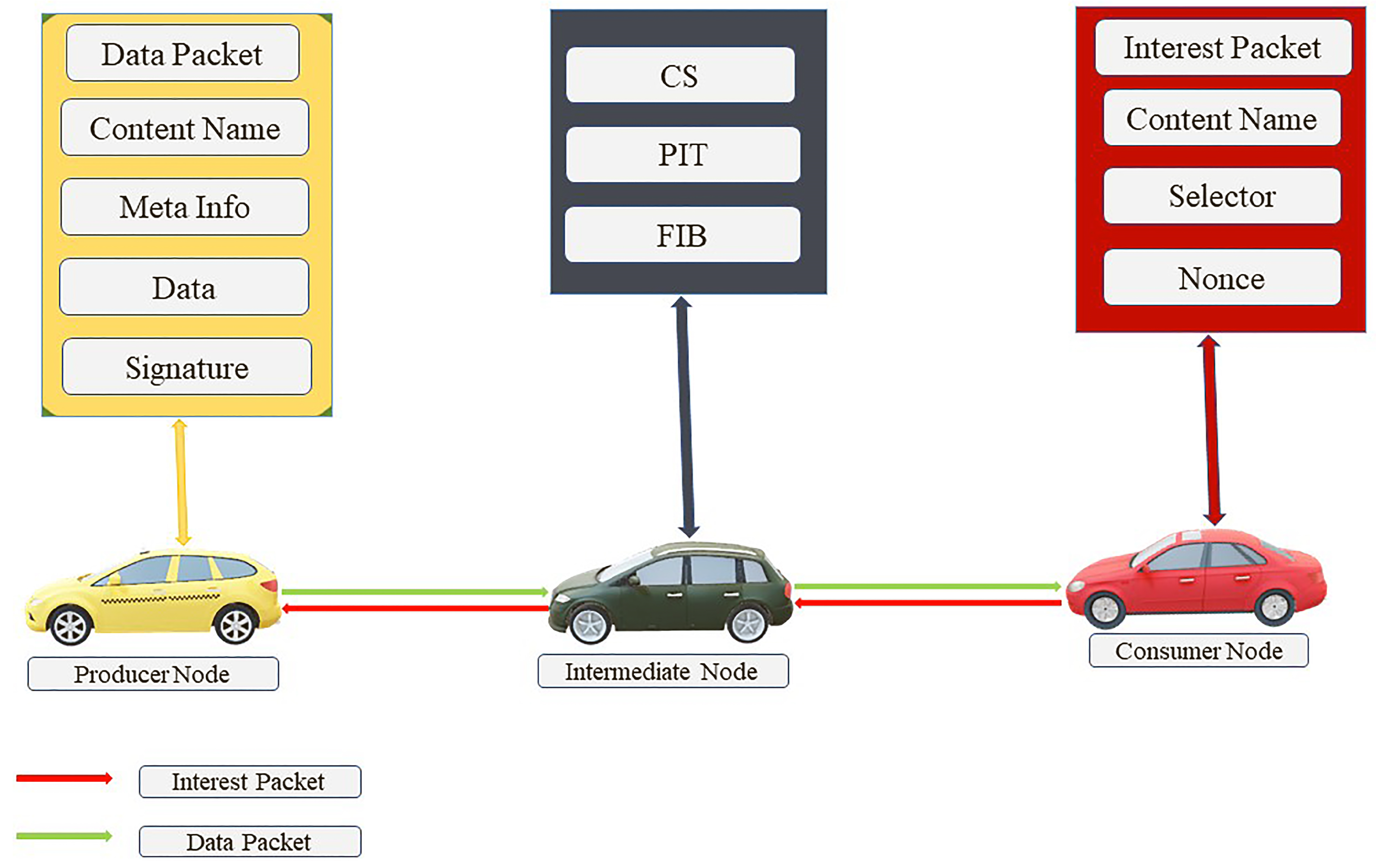

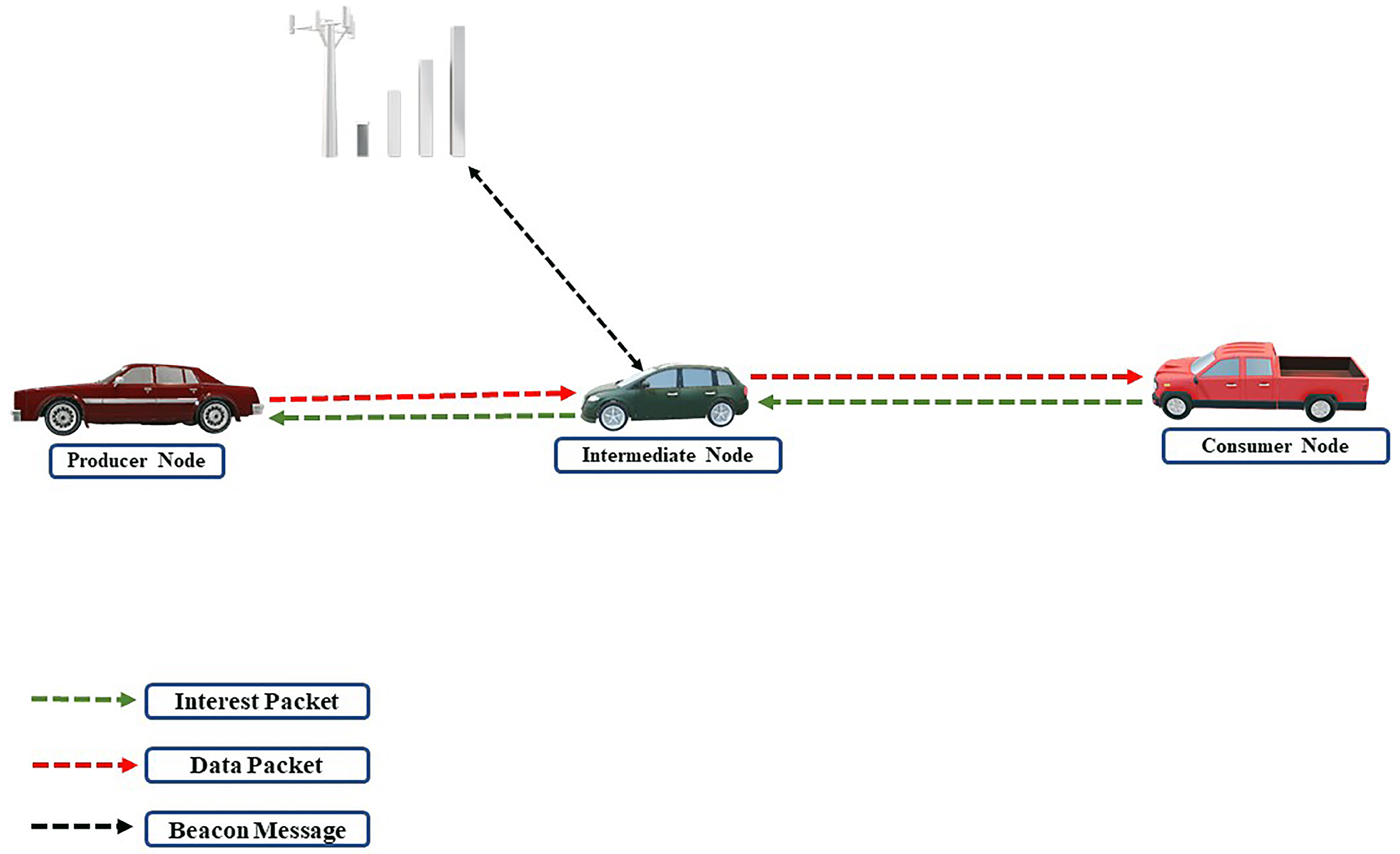
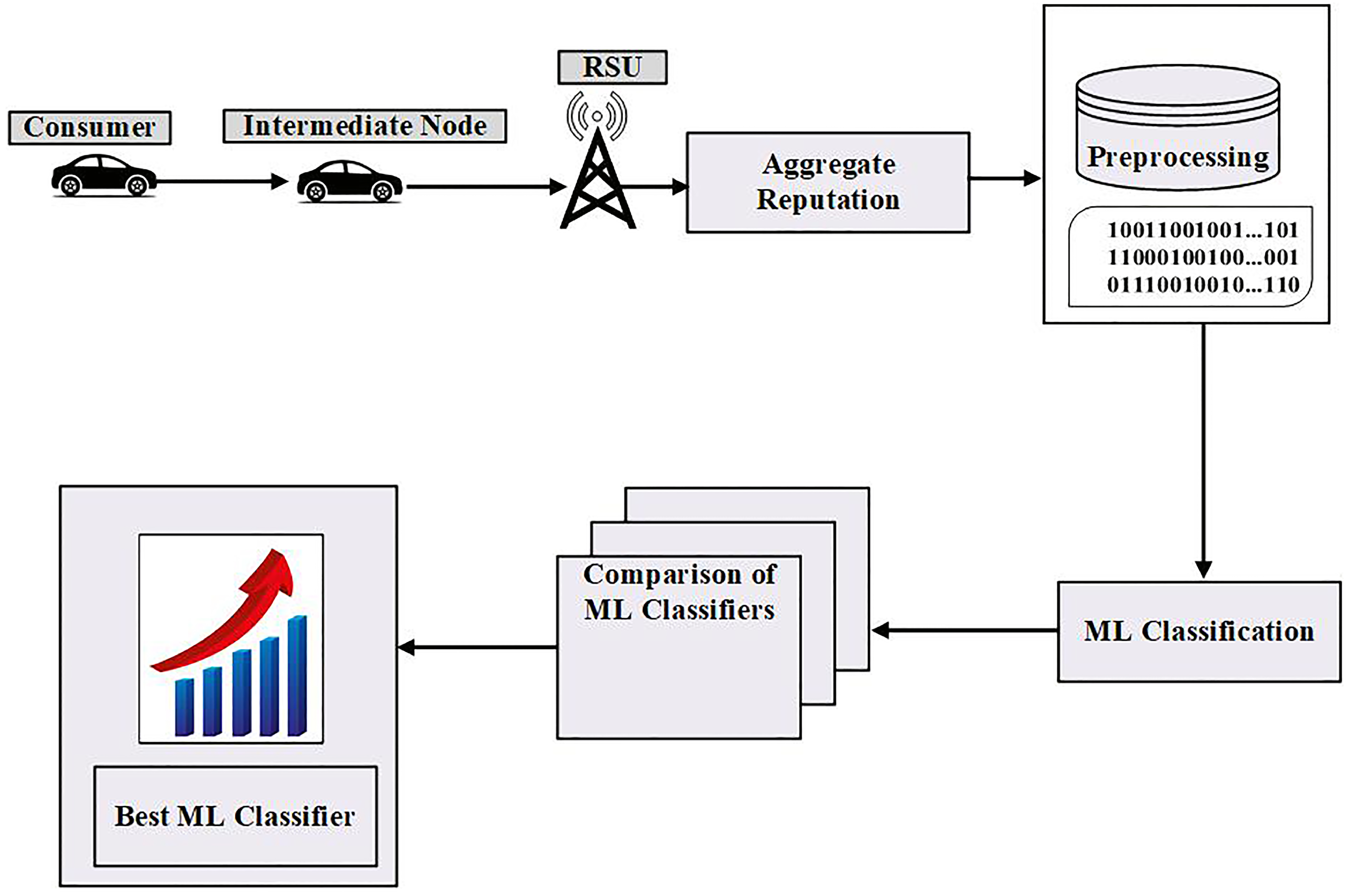
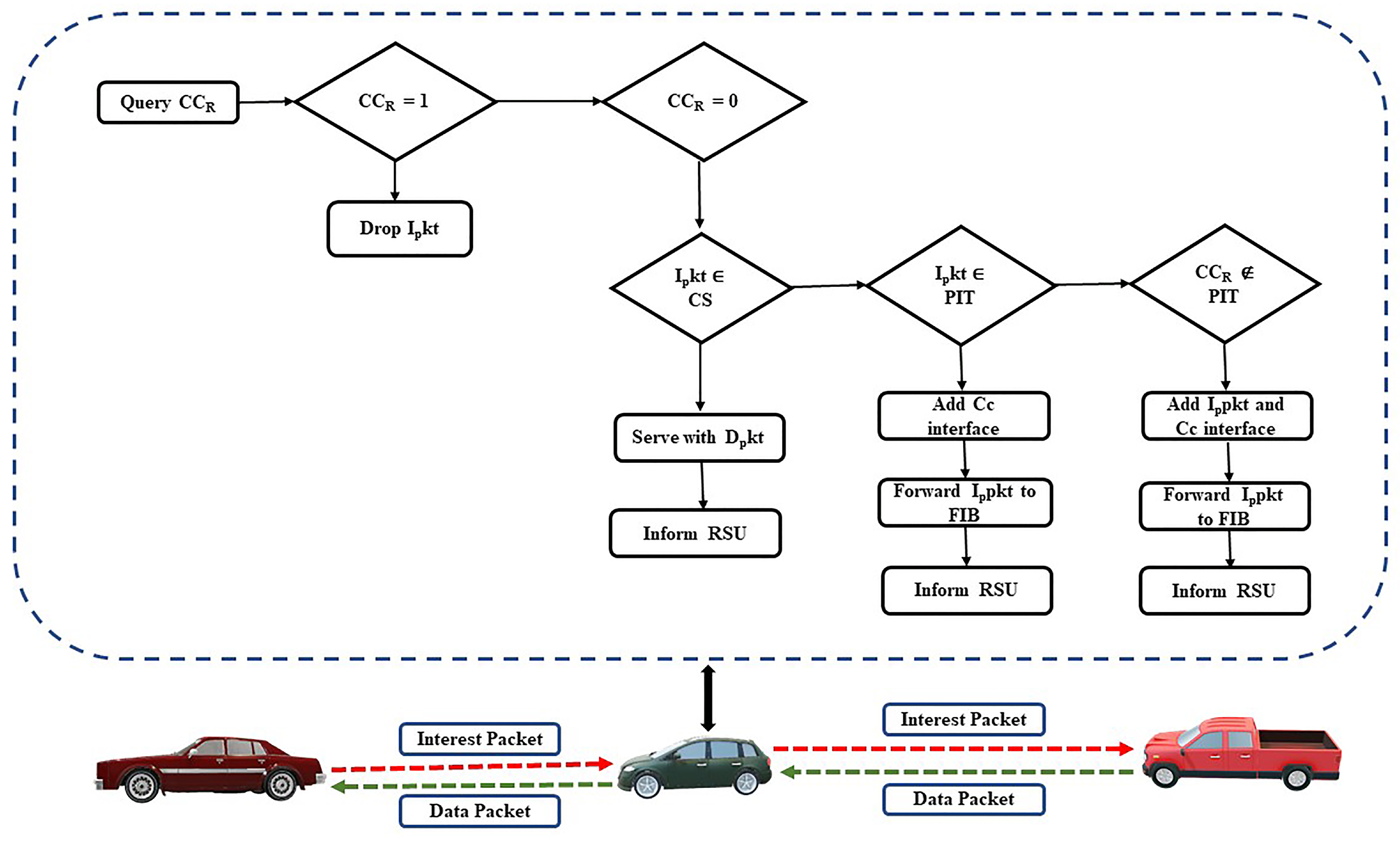
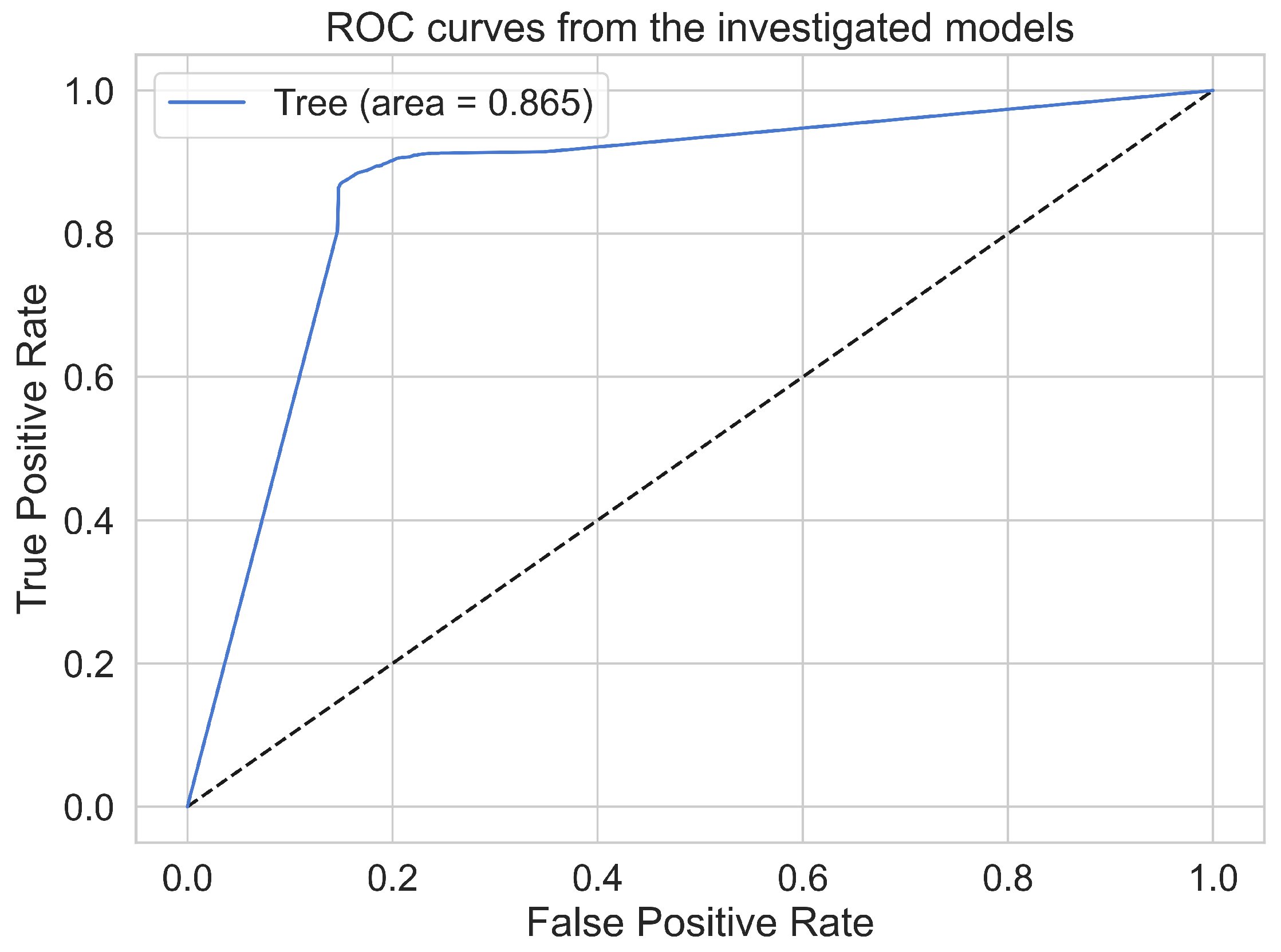







| Limitations of TCP/IP Communication | NDN-Based Solutions |
|---|---|
| It is host-oriented | It is a content-oriented network interested in content rather than the host. |
| It relies on IP addresses. | NDN uses unique content names that reduce the dependency on IP addresses. |
| It is connection-oriented. | NDN is a connectionless network architecture that does not require establishing explicit connections between two ends. |
| TCP/IP faces intermittent connectivity issues | The in-network content caching and name-based forwarding strategy support intermittent connectivity. |
| It secures the channel. | NDN secures content with a cryptographic signature rather than the communication channel. |
| It has limited scalability in large networks | NDN’s architecture allows for scalable content retrieval through its distributed caching mechanism, improving performance in large-scale networks. |
| Lack of inherent support for multi-cast. | NDN inherently supports multi-cast communication, enabling efficient dissemination of content to multiple recipients simultaneously. |
| Notation | Description |
|---|---|
| Content Consumer Reputation | |
| Data Packet | |
| Interest Packet | |
| Content | |
| Content Consumer | |
| Content Consumer New Reputation | |
| Content Consumer Previous Reputation | |
| Aggregate Content Consumer Reputation |
| ML Classifiers | Precision | Recall | F1 Score |
|---|---|---|---|
| DT | 0.85 | 0.87 | 0.86 |
| KNN | 0.87 | 0.81 | 0.84 |
| RF | 0.91 | 0.87 | 0.89 |
| NB | 0.99 | 0.57 | 0.72 |
| LR | 0.98 | 0.57 | 0.72 |
Disclaimer/Publisher’s Note: The statements, opinions and data contained in all publications are solely those of the individual author(s) and contributor(s) and not of MDPI and/or the editor(s). MDPI and/or the editor(s) disclaim responsibility for any injury to people or property resulting from any ideas, methods, instructions or products referred to in the content. |
© 2023 by the authors. Licensee MDPI, Basel, Switzerland. This article is an open access article distributed under the terms and conditions of the Creative Commons Attribution (CC BY) license (https://creativecommons.org/licenses/by/4.0/).
Share and Cite
Magsi, A.H.; Mohsan, S.A.H.; Muhammad, G.; Abbasi, S. A Machine Learning-Based Interest Flooding Attack Detection System in Vehicular Named Data Networking. Electronics 2023, 12, 3870. https://doi.org/10.3390/electronics12183870
Magsi AH, Mohsan SAH, Muhammad G, Abbasi S. A Machine Learning-Based Interest Flooding Attack Detection System in Vehicular Named Data Networking. Electronics. 2023; 12(18):3870. https://doi.org/10.3390/electronics12183870
Chicago/Turabian StyleMagsi, Arif Hussain, Syed Agha Hassnain Mohsan, Ghulam Muhammad, and Suhni Abbasi. 2023. "A Machine Learning-Based Interest Flooding Attack Detection System in Vehicular Named Data Networking" Electronics 12, no. 18: 3870. https://doi.org/10.3390/electronics12183870
APA StyleMagsi, A. H., Mohsan, S. A. H., Muhammad, G., & Abbasi, S. (2023). A Machine Learning-Based Interest Flooding Attack Detection System in Vehicular Named Data Networking. Electronics, 12(18), 3870. https://doi.org/10.3390/electronics12183870







